Market Equilibrium and Industry Changes: An In-Depth Economic Analysis
VerifiedAdded on 2023/06/11
|11
|1931
|306
Essay
AI Summary
This essay discusses market equilibrium, defined as the point where quantity demanded equals quantity supplied, and its role in determining industry dynamics. It examines how shifts in demand and supply impact market prices and quantities, referencing economic laws and examples such as t...
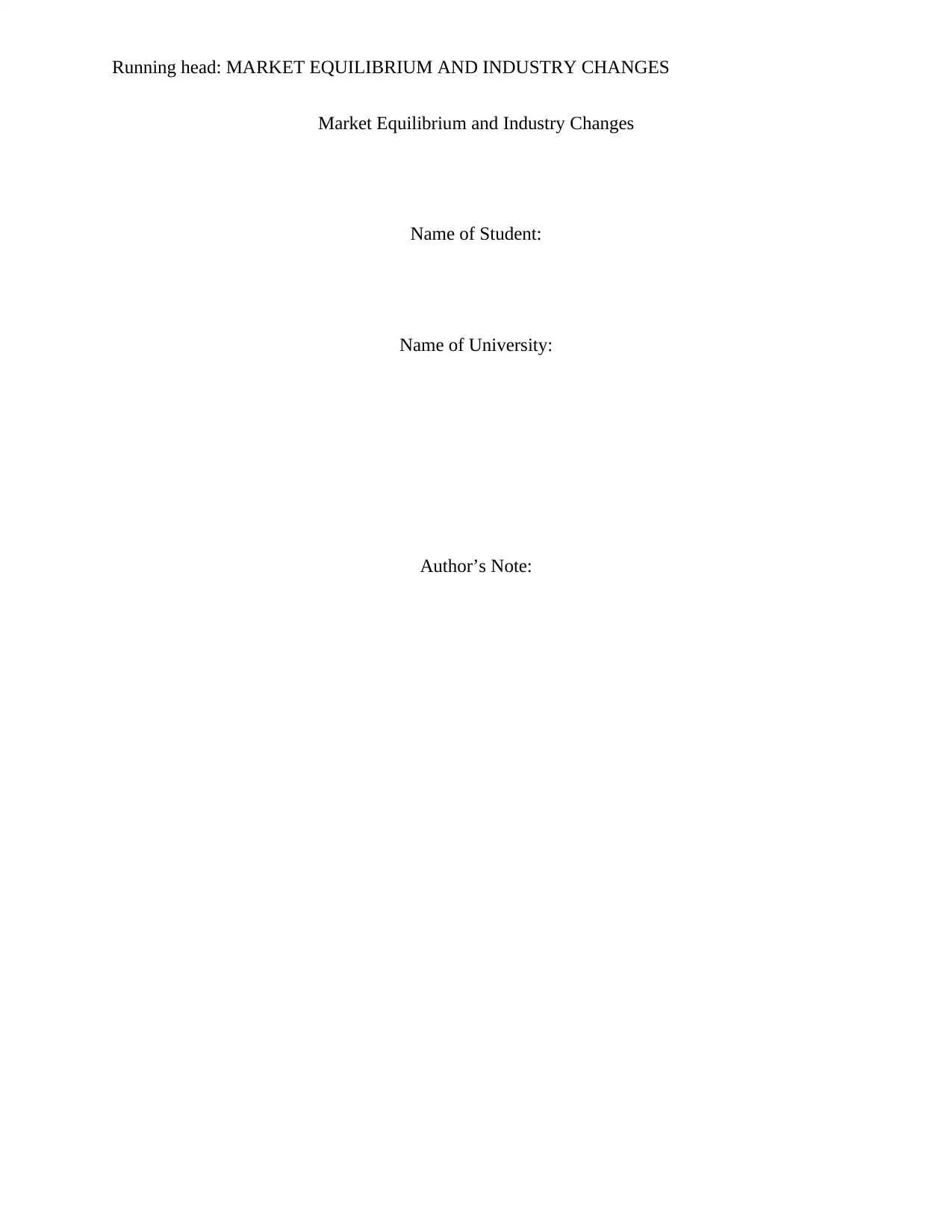
Running head: MARKET EQUILIBRIUM AND INDUSTRY CHANGES
Market Equilibrium and Industry Changes
Name of Student:
Name of University:
Author’s Note:
Market Equilibrium and Industry Changes
Name of Student:
Name of University:
Author’s Note:
Paraphrase This Document
Need a fresh take? Get an instant paraphrase of this document with our AI Paraphraser

1MARKET EQUILIBRIUM AND INDUSTRY CHANGES
Executive Summary
Market equilibrium is the market clearing price and output which is measured by the amount of
output sellers are willing, able to sell and buyers are willing to buy. The equilibrium determines
the market in which a firm operates. The effect of equilibrium price and quantity is a key factor
for investors and managers to anticipate future costs and make plans accordingly. However, this
equilibrium is different according to industry and commodity type.
Executive Summary
Market equilibrium is the market clearing price and output which is measured by the amount of
output sellers are willing, able to sell and buyers are willing to buy. The equilibrium determines
the market in which a firm operates. The effect of equilibrium price and quantity is a key factor
for investors and managers to anticipate future costs and make plans accordingly. However, this
equilibrium is different according to industry and commodity type.

2MARKET EQUILIBRIUM AND INDUSTRY CHANGES
Table of Contents
Introduction......................................................................................................................................3
Discussion........................................................................................................................................3
Conclusion.......................................................................................................................................7
Reference List..................................................................................................................................9
Table of Contents
Introduction......................................................................................................................................3
Discussion........................................................................................................................................3
Conclusion.......................................................................................................................................7
Reference List..................................................................................................................................9
⊘ This is a preview!⊘
Do you want full access?
Subscribe today to unlock all pages.

Trusted by 1+ million students worldwide

3MARKET EQUILIBRIUM AND INDUSTRY CHANGES
Introduction
Market equilibrium is the point where quantity demanded by the buyers equals to the
quantity supplied by the sellers at a particular price. The specified price is the market clearing
price because goods and services must be sold at that price with given amount of quantity. This
optimum equilibrium level is different according to industries. This is one of the most interesting
topics as market equilibrium has an important role to determine the type of industry in which a
firm operates. Industries transform themselves according to the demand and supply changes due
to market determined price and quantity. Industries and equilibrium level varies due to consumer
preference and availability of substitutes or complements (Cowell 2018).
Discussion
A market is a place where buyers and sellers meet and figure out the price of a product
along with the output level. According to the law of demand, demand for a commodity rises due
to fall in price and vice-versa, showing a negative relation (Karl 2019). Whereas, law of supply
says that with increase in price, supply goes up as selling goods are more profitable, showing a
positive relation. Thus, demand curve is downward sloping and supply curve is upward sloping.
The point where quantity demanded by consumers intersects with quantity supplied by sellers
gives equilibrium price. Let’s take an example.
Quantit
y Price of suppliers($) Price of consumers($)
1 32 6
2 30 8
3 28 10
4 26 12
5 25 16
6 24 18
7 23 19
8 20 20
Introduction
Market equilibrium is the point where quantity demanded by the buyers equals to the
quantity supplied by the sellers at a particular price. The specified price is the market clearing
price because goods and services must be sold at that price with given amount of quantity. This
optimum equilibrium level is different according to industries. This is one of the most interesting
topics as market equilibrium has an important role to determine the type of industry in which a
firm operates. Industries transform themselves according to the demand and supply changes due
to market determined price and quantity. Industries and equilibrium level varies due to consumer
preference and availability of substitutes or complements (Cowell 2018).
Discussion
A market is a place where buyers and sellers meet and figure out the price of a product
along with the output level. According to the law of demand, demand for a commodity rises due
to fall in price and vice-versa, showing a negative relation (Karl 2019). Whereas, law of supply
says that with increase in price, supply goes up as selling goods are more profitable, showing a
positive relation. Thus, demand curve is downward sloping and supply curve is upward sloping.
The point where quantity demanded by consumers intersects with quantity supplied by sellers
gives equilibrium price. Let’s take an example.
Quantit
y Price of suppliers($) Price of consumers($)
1 32 6
2 30 8
3 28 10
4 26 12
5 25 16
6 24 18
7 23 19
8 20 20
Paraphrase This Document
Need a fresh take? Get an instant paraphrase of this document with our AI Paraphraser

4MARKET EQUILIBRIUM AND INDUSTRY CHANGES
9 16 23
10 15 26
11 12 28
12 11 30
Table1: Quantity determined by Buyers and Sellers at each price
Source: As created by author
0 2 4 6 8 10 12 14
0
5
10
15
20
25
30
35
Market Equilibrium
Price of suppliers($) Price of consumers($)
Quantity Deamnded
Price
Figure1: Market equilibrium price and quantity
Source: As created by author
$20 is the equilibrium price at quantity 8, where both consumers and suppliers are
satisfied.
Market equilibrium is a crucial economic tool to forecast about changes in market demand,
supply. An increase in demand shifts demand curve rightward and price increases subsequently
as supply cannot be increased immediately (Kreps 2013). The change in market demand is
reflexive of the elasticity of demand and supply curves. Goods having more elastic demand does
not show much responsiveness with respect to price where elasticity is described as the change in
9 16 23
10 15 26
11 12 28
12 11 30
Table1: Quantity determined by Buyers and Sellers at each price
Source: As created by author
0 2 4 6 8 10 12 14
0
5
10
15
20
25
30
35
Market Equilibrium
Price of suppliers($) Price of consumers($)
Quantity Deamnded
Price
Figure1: Market equilibrium price and quantity
Source: As created by author
$20 is the equilibrium price at quantity 8, where both consumers and suppliers are
satisfied.
Market equilibrium is a crucial economic tool to forecast about changes in market demand,
supply. An increase in demand shifts demand curve rightward and price increases subsequently
as supply cannot be increased immediately (Kreps 2013). The change in market demand is
reflexive of the elasticity of demand and supply curves. Goods having more elastic demand does
not show much responsiveness with respect to price where elasticity is described as the change in
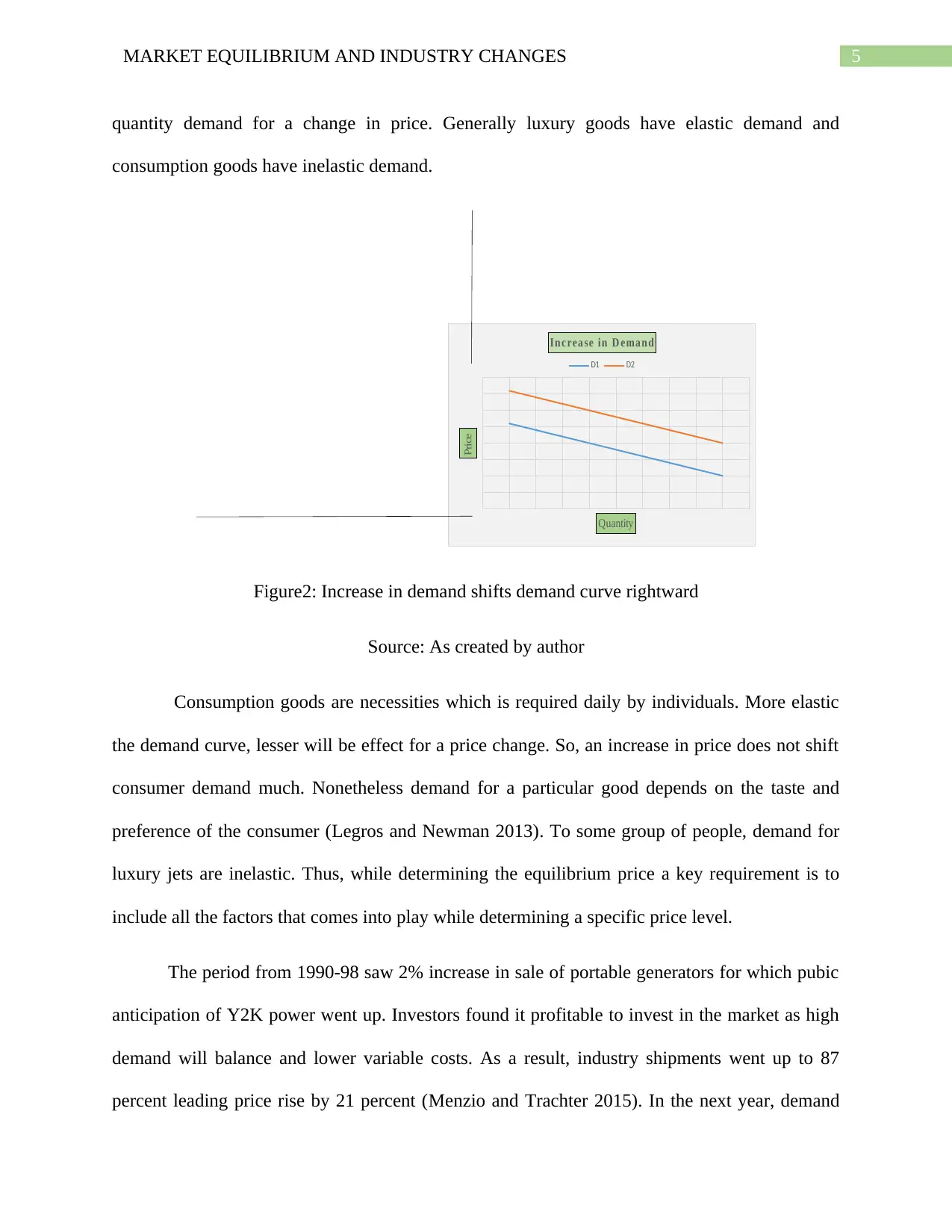
5MARKET EQUILIBRIUM AND INDUSTRY CHANGES
quantity demand for a change in price. Generally luxury goods have elastic demand and
consumption goods have inelastic demand.
Inc rea se in D eman d
D1 D2
Quantity
Price
Figure2: Increase in demand shifts demand curve rightward
Source: As created by author
Consumption goods are necessities which is required daily by individuals. More elastic
the demand curve, lesser will be effect for a price change. So, an increase in price does not shift
consumer demand much. Nonetheless demand for a particular good depends on the taste and
preference of the consumer (Legros and Newman 2013). To some group of people, demand for
luxury jets are inelastic. Thus, while determining the equilibrium price a key requirement is to
include all the factors that comes into play while determining a specific price level.
The period from 1990-98 saw 2% increase in sale of portable generators for which pubic
anticipation of Y2K power went up. Investors found it profitable to invest in the market as high
demand will balance and lower variable costs. As a result, industry shipments went up to 87
percent leading price rise by 21 percent (Menzio and Trachter 2015). In the next year, demand
quantity demand for a change in price. Generally luxury goods have elastic demand and
consumption goods have inelastic demand.
Inc rea se in D eman d
D1 D2
Quantity
Price
Figure2: Increase in demand shifts demand curve rightward
Source: As created by author
Consumption goods are necessities which is required daily by individuals. More elastic
the demand curve, lesser will be effect for a price change. So, an increase in price does not shift
consumer demand much. Nonetheless demand for a particular good depends on the taste and
preference of the consumer (Legros and Newman 2013). To some group of people, demand for
luxury jets are inelastic. Thus, while determining the equilibrium price a key requirement is to
include all the factors that comes into play while determining a specific price level.
The period from 1990-98 saw 2% increase in sale of portable generators for which pubic
anticipation of Y2K power went up. Investors found it profitable to invest in the market as high
demand will balance and lower variable costs. As a result, industry shipments went up to 87
percent leading price rise by 21 percent (Menzio and Trachter 2015). In the next year, demand
⊘ This is a preview!⊘
Do you want full access?
Subscribe today to unlock all pages.

Trusted by 1+ million students worldwide
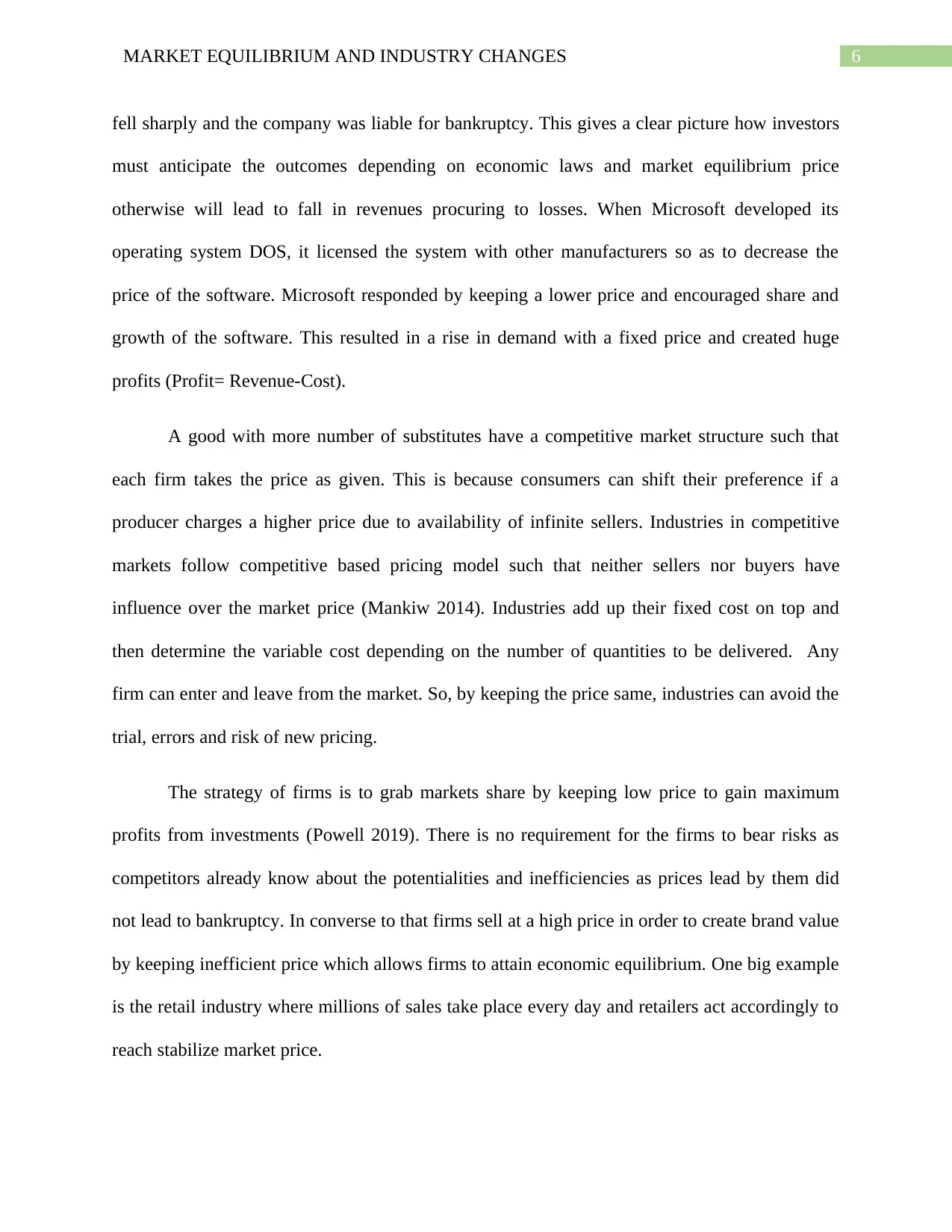
6MARKET EQUILIBRIUM AND INDUSTRY CHANGES
fell sharply and the company was liable for bankruptcy. This gives a clear picture how investors
must anticipate the outcomes depending on economic laws and market equilibrium price
otherwise will lead to fall in revenues procuring to losses. When Microsoft developed its
operating system DOS, it licensed the system with other manufacturers so as to decrease the
price of the software. Microsoft responded by keeping a lower price and encouraged share and
growth of the software. This resulted in a rise in demand with a fixed price and created huge
profits (Profit= Revenue-Cost).
A good with more number of substitutes have a competitive market structure such that
each firm takes the price as given. This is because consumers can shift their preference if a
producer charges a higher price due to availability of infinite sellers. Industries in competitive
markets follow competitive based pricing model such that neither sellers nor buyers have
influence over the market price (Mankiw 2014). Industries add up their fixed cost on top and
then determine the variable cost depending on the number of quantities to be delivered. Any
firm can enter and leave from the market. So, by keeping the price same, industries can avoid the
trial, errors and risk of new pricing.
The strategy of firms is to grab markets share by keeping low price to gain maximum
profits from investments (Powell 2019). There is no requirement for the firms to bear risks as
competitors already know about the potentialities and inefficiencies as prices lead by them did
not lead to bankruptcy. In converse to that firms sell at a high price in order to create brand value
by keeping inefficient price which allows firms to attain economic equilibrium. One big example
is the retail industry where millions of sales take place every day and retailers act accordingly to
reach stabilize market price.
fell sharply and the company was liable for bankruptcy. This gives a clear picture how investors
must anticipate the outcomes depending on economic laws and market equilibrium price
otherwise will lead to fall in revenues procuring to losses. When Microsoft developed its
operating system DOS, it licensed the system with other manufacturers so as to decrease the
price of the software. Microsoft responded by keeping a lower price and encouraged share and
growth of the software. This resulted in a rise in demand with a fixed price and created huge
profits (Profit= Revenue-Cost).
A good with more number of substitutes have a competitive market structure such that
each firm takes the price as given. This is because consumers can shift their preference if a
producer charges a higher price due to availability of infinite sellers. Industries in competitive
markets follow competitive based pricing model such that neither sellers nor buyers have
influence over the market price (Mankiw 2014). Industries add up their fixed cost on top and
then determine the variable cost depending on the number of quantities to be delivered. Any
firm can enter and leave from the market. So, by keeping the price same, industries can avoid the
trial, errors and risk of new pricing.
The strategy of firms is to grab markets share by keeping low price to gain maximum
profits from investments (Powell 2019). There is no requirement for the firms to bear risks as
competitors already know about the potentialities and inefficiencies as prices lead by them did
not lead to bankruptcy. In converse to that firms sell at a high price in order to create brand value
by keeping inefficient price which allows firms to attain economic equilibrium. One big example
is the retail industry where millions of sales take place every day and retailers act accordingly to
reach stabilize market price.
Paraphrase This Document
Need a fresh take? Get an instant paraphrase of this document with our AI Paraphraser
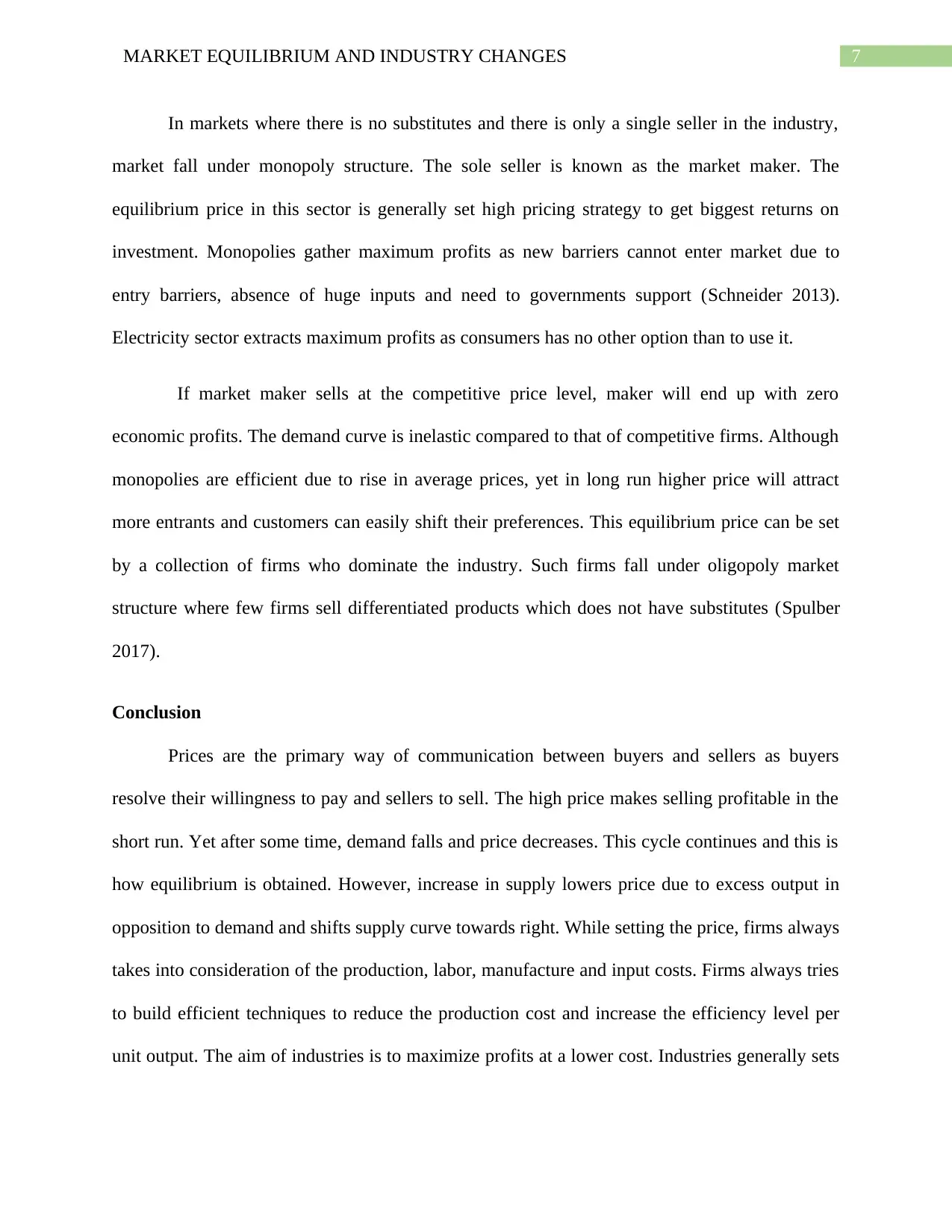
7MARKET EQUILIBRIUM AND INDUSTRY CHANGES
In markets where there is no substitutes and there is only a single seller in the industry,
market fall under monopoly structure. The sole seller is known as the market maker. The
equilibrium price in this sector is generally set high pricing strategy to get biggest returns on
investment. Monopolies gather maximum profits as new barriers cannot enter market due to
entry barriers, absence of huge inputs and need to governments support (Schneider 2013).
Electricity sector extracts maximum profits as consumers has no other option than to use it.
If market maker sells at the competitive price level, maker will end up with zero
economic profits. The demand curve is inelastic compared to that of competitive firms. Although
monopolies are efficient due to rise in average prices, yet in long run higher price will attract
more entrants and customers can easily shift their preferences. This equilibrium price can be set
by a collection of firms who dominate the industry. Such firms fall under oligopoly market
structure where few firms sell differentiated products which does not have substitutes (Spulber
2017).
Conclusion
Prices are the primary way of communication between buyers and sellers as buyers
resolve their willingness to pay and sellers to sell. The high price makes selling profitable in the
short run. Yet after some time, demand falls and price decreases. This cycle continues and this is
how equilibrium is obtained. However, increase in supply lowers price due to excess output in
opposition to demand and shifts supply curve towards right. While setting the price, firms always
takes into consideration of the production, labor, manufacture and input costs. Firms always tries
to build efficient techniques to reduce the production cost and increase the efficiency level per
unit output. The aim of industries is to maximize profits at a lower cost. Industries generally sets
In markets where there is no substitutes and there is only a single seller in the industry,
market fall under monopoly structure. The sole seller is known as the market maker. The
equilibrium price in this sector is generally set high pricing strategy to get biggest returns on
investment. Monopolies gather maximum profits as new barriers cannot enter market due to
entry barriers, absence of huge inputs and need to governments support (Schneider 2013).
Electricity sector extracts maximum profits as consumers has no other option than to use it.
If market maker sells at the competitive price level, maker will end up with zero
economic profits. The demand curve is inelastic compared to that of competitive firms. Although
monopolies are efficient due to rise in average prices, yet in long run higher price will attract
more entrants and customers can easily shift their preferences. This equilibrium price can be set
by a collection of firms who dominate the industry. Such firms fall under oligopoly market
structure where few firms sell differentiated products which does not have substitutes (Spulber
2017).
Conclusion
Prices are the primary way of communication between buyers and sellers as buyers
resolve their willingness to pay and sellers to sell. The high price makes selling profitable in the
short run. Yet after some time, demand falls and price decreases. This cycle continues and this is
how equilibrium is obtained. However, increase in supply lowers price due to excess output in
opposition to demand and shifts supply curve towards right. While setting the price, firms always
takes into consideration of the production, labor, manufacture and input costs. Firms always tries
to build efficient techniques to reduce the production cost and increase the efficiency level per
unit output. The aim of industries is to maximize profits at a lower cost. Industries generally sets
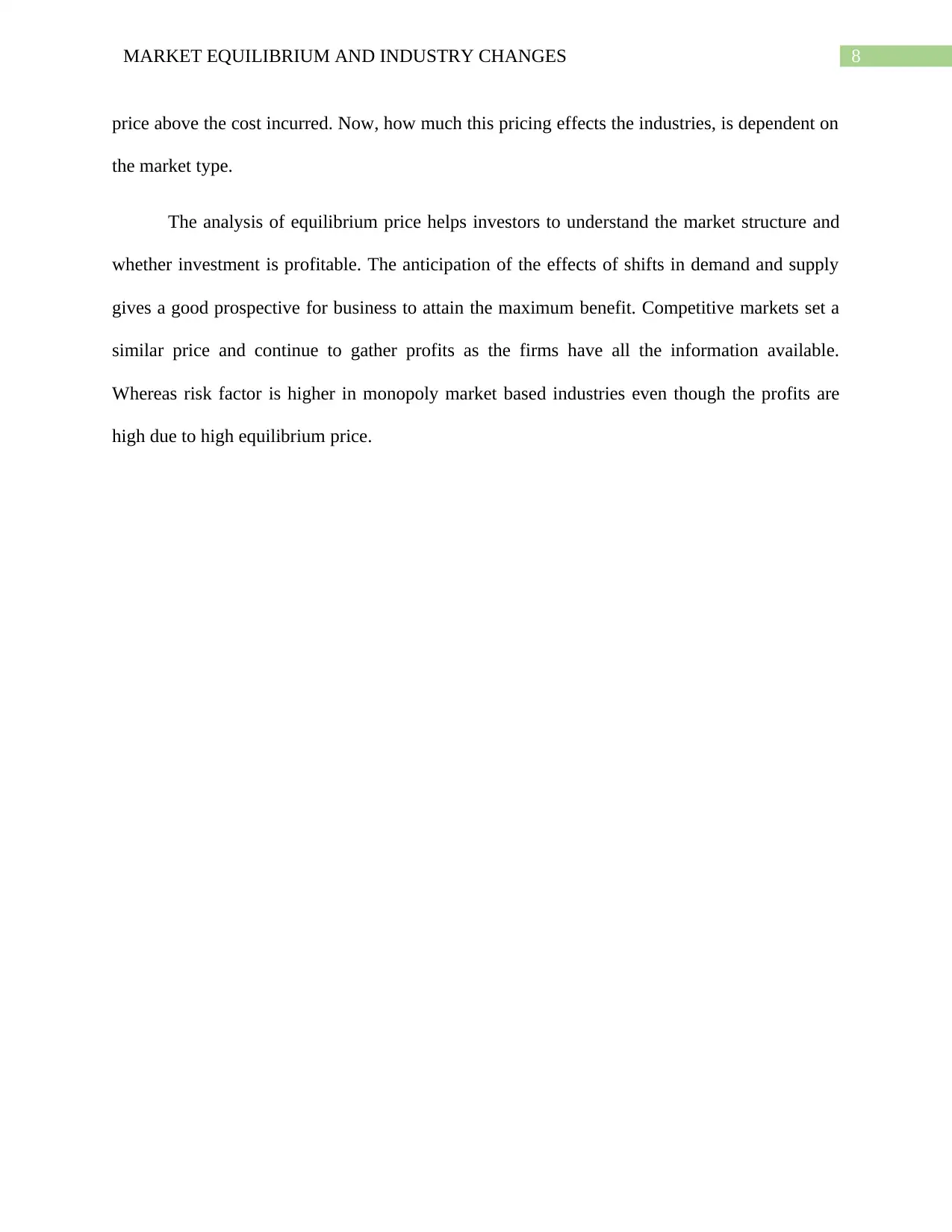
8MARKET EQUILIBRIUM AND INDUSTRY CHANGES
price above the cost incurred. Now, how much this pricing effects the industries, is dependent on
the market type.
The analysis of equilibrium price helps investors to understand the market structure and
whether investment is profitable. The anticipation of the effects of shifts in demand and supply
gives a good prospective for business to attain the maximum benefit. Competitive markets set a
similar price and continue to gather profits as the firms have all the information available.
Whereas risk factor is higher in monopoly market based industries even though the profits are
high due to high equilibrium price.
price above the cost incurred. Now, how much this pricing effects the industries, is dependent on
the market type.
The analysis of equilibrium price helps investors to understand the market structure and
whether investment is profitable. The anticipation of the effects of shifts in demand and supply
gives a good prospective for business to attain the maximum benefit. Competitive markets set a
similar price and continue to gather profits as the firms have all the information available.
Whereas risk factor is higher in monopoly market based industries even though the profits are
high due to high equilibrium price.
⊘ This is a preview!⊘
Do you want full access?
Subscribe today to unlock all pages.

Trusted by 1+ million students worldwide
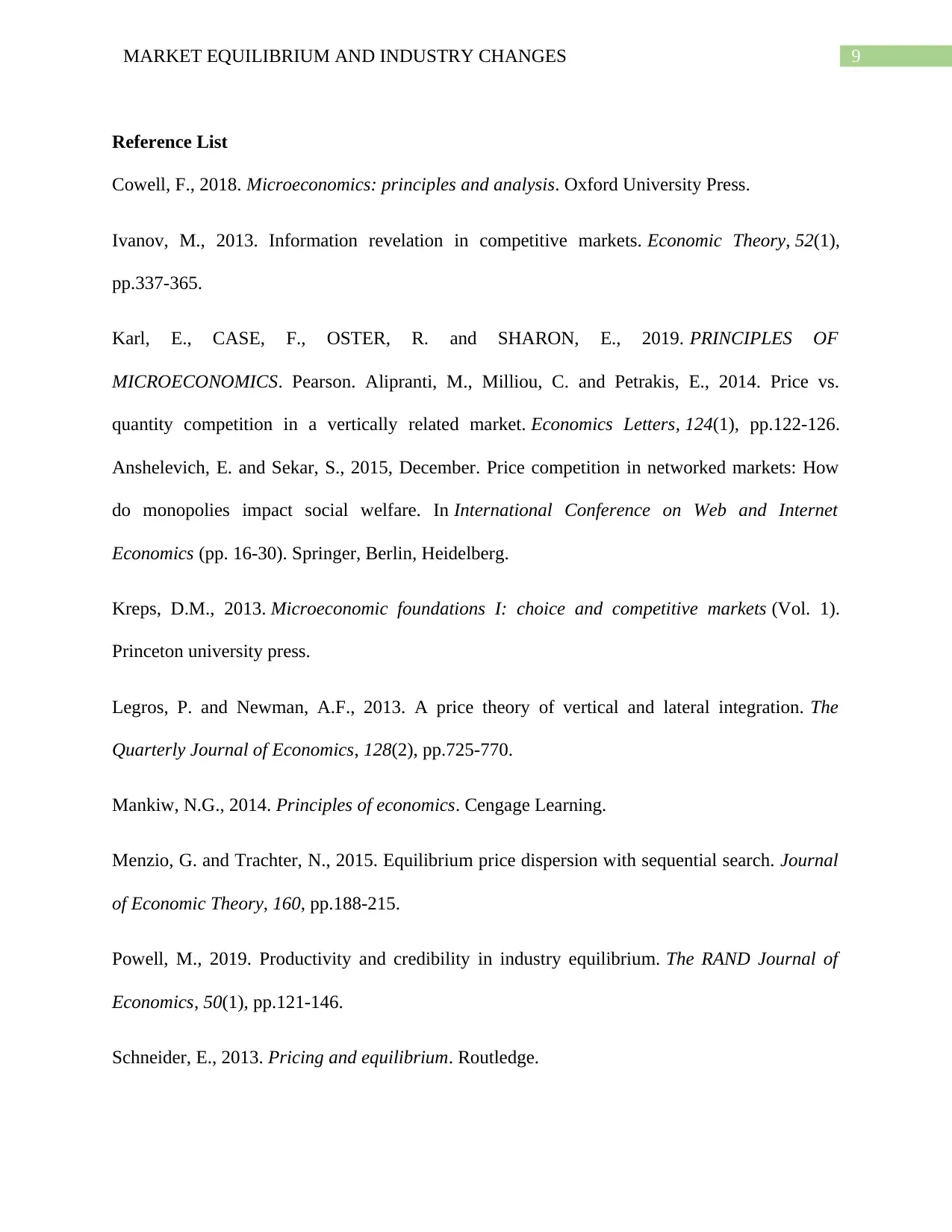
9MARKET EQUILIBRIUM AND INDUSTRY CHANGES
Reference List
Cowell, F., 2018. Microeconomics: principles and analysis. Oxford University Press.
Ivanov, M., 2013. Information revelation in competitive markets. Economic Theory, 52(1),
pp.337-365.
Karl, E., CASE, F., OSTER, R. and SHARON, E., 2019. PRINCIPLES OF
MICROECONOMICS. Pearson. Alipranti, M., Milliou, C. and Petrakis, E., 2014. Price vs.
quantity competition in a vertically related market. Economics Letters, 124(1), pp.122-126.
Anshelevich, E. and Sekar, S., 2015, December. Price competition in networked markets: How
do monopolies impact social welfare. In International Conference on Web and Internet
Economics (pp. 16-30). Springer, Berlin, Heidelberg.
Kreps, D.M., 2013. Microeconomic foundations I: choice and competitive markets (Vol. 1).
Princeton university press.
Legros, P. and Newman, A.F., 2013. A price theory of vertical and lateral integration. The
Quarterly Journal of Economics, 128(2), pp.725-770.
Mankiw, N.G., 2014. Principles of economics. Cengage Learning.
Menzio, G. and Trachter, N., 2015. Equilibrium price dispersion with sequential search. Journal
of Economic Theory, 160, pp.188-215.
Powell, M., 2019. Productivity and credibility in industry equilibrium. The RAND Journal of
Economics, 50(1), pp.121-146.
Schneider, E., 2013. Pricing and equilibrium. Routledge.
Reference List
Cowell, F., 2018. Microeconomics: principles and analysis. Oxford University Press.
Ivanov, M., 2013. Information revelation in competitive markets. Economic Theory, 52(1),
pp.337-365.
Karl, E., CASE, F., OSTER, R. and SHARON, E., 2019. PRINCIPLES OF
MICROECONOMICS. Pearson. Alipranti, M., Milliou, C. and Petrakis, E., 2014. Price vs.
quantity competition in a vertically related market. Economics Letters, 124(1), pp.122-126.
Anshelevich, E. and Sekar, S., 2015, December. Price competition in networked markets: How
do monopolies impact social welfare. In International Conference on Web and Internet
Economics (pp. 16-30). Springer, Berlin, Heidelberg.
Kreps, D.M., 2013. Microeconomic foundations I: choice and competitive markets (Vol. 1).
Princeton university press.
Legros, P. and Newman, A.F., 2013. A price theory of vertical and lateral integration. The
Quarterly Journal of Economics, 128(2), pp.725-770.
Mankiw, N.G., 2014. Principles of economics. Cengage Learning.
Menzio, G. and Trachter, N., 2015. Equilibrium price dispersion with sequential search. Journal
of Economic Theory, 160, pp.188-215.
Powell, M., 2019. Productivity and credibility in industry equilibrium. The RAND Journal of
Economics, 50(1), pp.121-146.
Schneider, E., 2013. Pricing and equilibrium. Routledge.
Paraphrase This Document
Need a fresh take? Get an instant paraphrase of this document with our AI Paraphraser
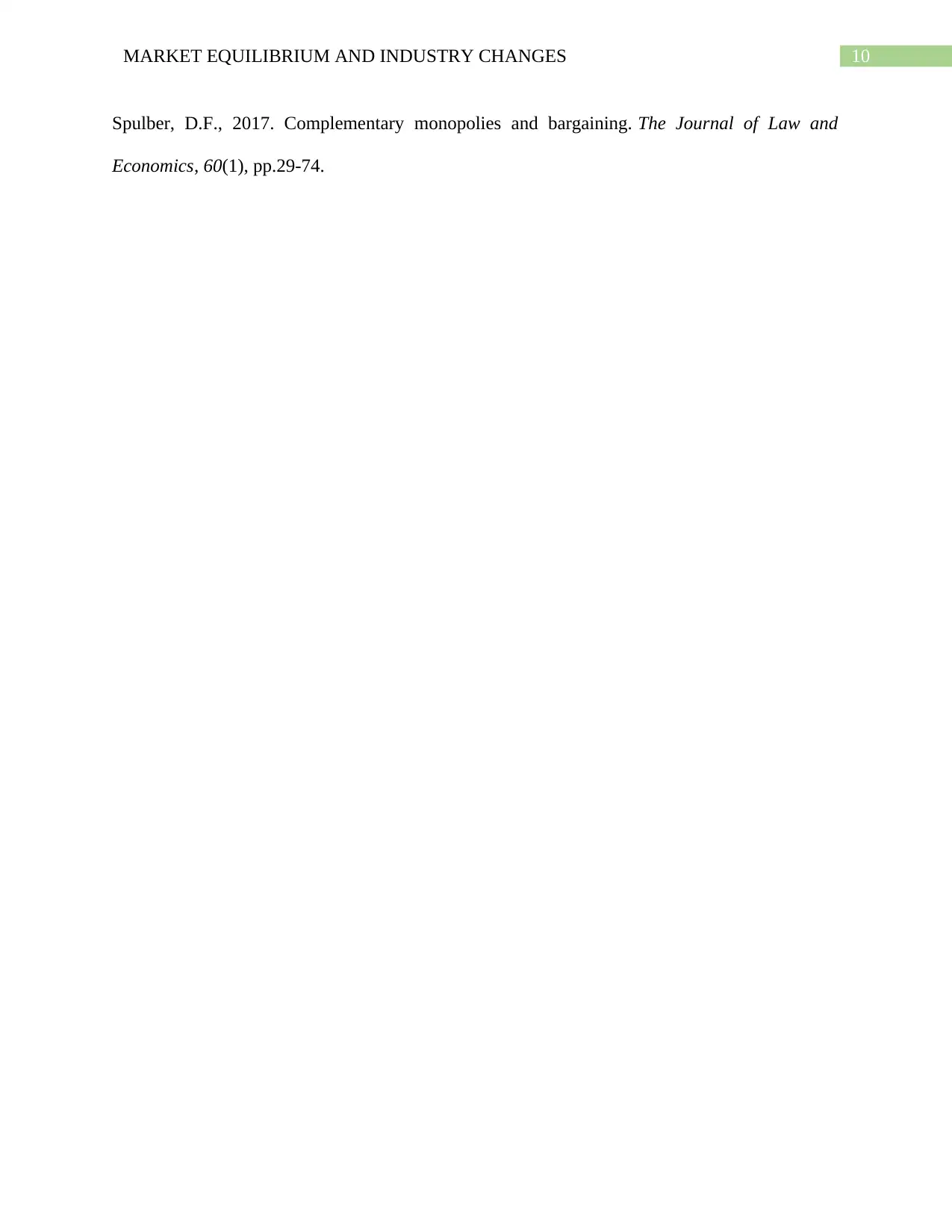
10MARKET EQUILIBRIUM AND INDUSTRY CHANGES
Spulber, D.F., 2017. Complementary monopolies and bargaining. The Journal of Law and
Economics, 60(1), pp.29-74.
Spulber, D.F., 2017. Complementary monopolies and bargaining. The Journal of Law and
Economics, 60(1), pp.29-74.
1 out of 11
Related Documents
Your All-in-One AI-Powered Toolkit for Academic Success.
+13062052269
info@desklib.com
Available 24*7 on WhatsApp / Email
![[object Object]](/_next/static/media/star-bottom.7253800d.svg)
Unlock your academic potential
© 2024 | Zucol Services PVT LTD | All rights reserved.




